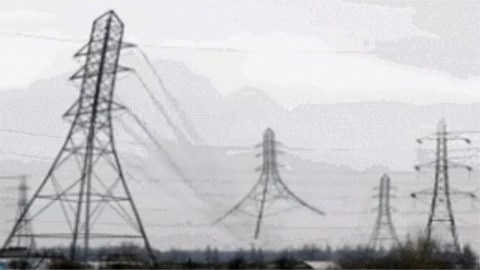It Was the Dress in 2015. In 2017 It’s the Silent Gif People Can Hear.

You certainly remember The Dress from 2015 and the viral internet debate regarding what color it really was. This year it’s a silent animated gif showing three electrical pylons playing jump rope — the odd thing is that many people can hear it.

The gif was actually created by Twitter user I Am Happy Toast back in 2008 as part of a Photoshop challenge, and it appeared in British parallel-universe comedy show The Wrong Door. What set off the current uproar was a December 4 tweet by Scottish scientist Lisa DeBruine.
Does anyone in visual perception know why you can hear this gif? pic.twitter.com/mcT22Lzfkp
— Lisa DeBruine (@lisadebruine) December 2, 2017
She asked her followers what, if anything, they hear when the watch the gif. 315,483 people have responded to her poll as of this writing. But that’s just the tip of the iceberg, since the whole thing has gone viral. One of the things that intrigued DeBruine was why some hear the sound and others don’t, as reflected in her tweet’s survey.
Her basic question has yet to be definitively answered, though, but there are certainly some interesting theories. The early favorite on her feed was that the pylon in the middle is jumping at a tempo very similar to the human heartbeat, and so it’s their own hearts that people are hearing. This theory actually makes sense only if your heartbeat happens to be in sync with the pylon, which is vanishingly unlikely. Anyone who’s ever tried to get two pieces of music at the same tempo to play back in time can attest to this — it only happens when they line up exactly. DeBruine quickly put the kibosh on this one On the other hand, as long as we’re talking viral videos, why does this eventually happen to unsynchronized metronomes? (It does take significantly longer to achieve its effect than the gif.)
It didn’t take long, however, for the discussion to center on the camera shake that occurs when the jumper lands. I Am Happy Toast himself got into the conversation, showing how the effect still happens when the towers are cropped out, leaving just the shake.
The thump is almost entirely in the shake, if you crop out the pylons themselves you can still hear it. They just give it height. pic.twitter.com/3LZK1g24yZ
— HappyToast (@IamHappyToast) December 4, 2017
He also notes that in The Wrong Door, there’s no shake, and no boom.
I’ve tracked down a copy of the pylons as they appeared in The Wrong Door – No ground shake and therefore no perceived noise! @lisadebruinepic.twitter.com/KzHw2crPlR
— HappyToast (@IamHappyToast) December 7, 2017
A couple of other examples with a camera shake back up his point. This one’s from My Neighbor Totoro, and it, too, booms.

(giphy)
This seesaw go doesn’t boom, it snaps. Still…

Tweeter Aaron Carlson noted a phenomenon that may begin to get at what’s going on for those who hear the gif.
The gif shake seems to cause me to have an extremely minute muscle tensing around my ears (bracing for impact?). I think this is where the sound is coming from for me at least.
— Aaron Carlson (@crazycarl864) December 4, 2017
Jonathan Toolan tweeted his young son’s reaction to the gif: “7 year old son’s report on skipping pylon: ‘I can’t hear it, but my body can feel it.'”
Avowed technoanarchist Andrew Kemendo puts this in a more sciency, sensible way:
Look into Correlated neuronal activity. The brain is “expecting/predicting” what is coming visually and then fires a version of what it expects across the relevant senses. Also explains why some might “feel” a physical shake https://t.co/erpiCiv5hX
— Andrew Kemendo (@AndrewKemendo) December 3, 2017
Another, not completely unrelated theory comes from Christopher Fassnidge, a University of London scientist, who spoke to the BBC. He suggests a kind of movement-to-sound synesthesia. Fassnidge is studying what he calls “vEAR” — for “Visually-Evoked Auditory Response” — which he says is a phenomenon experienced in daily life by around 20% of us, much higher than the generally reported incidence of synesthesia.
“We are constantly surrounded by movements that make a sound, whether they are footsteps as people walk, lip movements while they talk, a ball bouncing in the playground, or the crash as we drop a glass. There is some evidence to suggest that synaesthetic pairings are, to some extent, learnt during infancy.”
Fassnidge offers this example: “I might assume I am hearing the footsteps of a person walking on the other side of the street, when really the sound exists only in my mind.”
There hasn’t yet been a lot of research into vEAR, but Fassnidge is conducting a survey, if you’re interested.
The truth may be one of these theories or something not yet posited — what do you think? Is it something else entirely?





